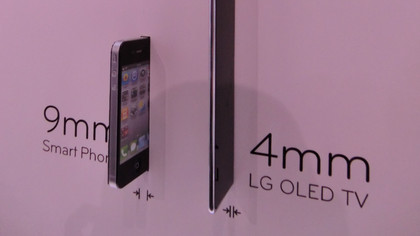Why the iPhone 5 doesn't have an AMOLED screen
'Mainstream' display ignored by Apple, but why?

It's 123.8mm long and its much-hyped Retina screen measures an impressive 1,136 x 640 pixels – achieving an eye-popping 326 pixels per inch – but does the iPhone 5 have the high-end screen it should?
It is, after all, only using a LCD display, not the latest AMOLED panel. Offering a larger colour gamut, better contrast, and much faster response time than LCD, AMOLED (that's active-matrix organic light-emitting diode, to you) is now routinely used throughout the high-end smartphone market, with the Nokia Lumia 900, Motorola Razr i, Samsung Galaxy S3 and Galaxy Note 2 just a few of the full-screen devices sporting the latest and greatest touchscreen tech.
AMOLED is even being used in cameras, so why is it missing from the iPhone 5?
"Apple is not ignoring OLED," says analyst Ken Werner, Principle at Connecticut, USA-based Nutmeg Consultants, who deems AMOLED a 'mainstream' tech for smartphones, "but there has not been a sufficient number of smartphone-sized OLED displays available to cover the number of iPhones Apple produces."
Apple – which sold over 140 million iPhones in 2010 and 2011 – broke its own records in the wake of the iPhone 5's announcement by racking-up two million pre-order sales in just 24 hours.
Legal battles
As well as the iPhone 5 being too big a product launch for AMOLED to grace, there's also the small matter of the supply being dominated by Samsung Display, which makes over 90% of AMOLED screens. "Now Apple and Samsung are engaged in intense legal battles," says Werner, "it is unlikely that Apple would want its arch-rival to also be its single source for OLED displays."

Werner points out that Samsung is barely able to supply its own needs for smartphones and devices; its Galaxy Note has a 5.3-inch AMOLED display, but the new Galaxy Note 10.1-inch has an LCD display. "As for tablets," says Werner, "10-inch OLED displays would now be too expensive to make a tablet at a competitive price." That said, AMOLED is being used at the smaller end of the market, with the Samsung Galaxy Tab 7.7 claiming an AMOLED panel.
Sign up for breaking news, reviews, opinion, top tech deals, and more.
Another possible reason for Apple's swerving of AMOLED is resolution. The in-situ screen in the iPhone 5 presents 326 pixels per inch (PPI), whereas pixel densities for AMOLED currently reach around 250 PPI, though 280 PPI is now possible. "High resolution continues to be a relative weakness for small and medium AMOLED compared to LCDs," says Jae-Hak Choi, Senior Analyst for FPD Manufacturing at NPD DisplaySearch.
Missing tech
The lack of an AMOLED screen isn't the only slab of 'missing' tech from the iPhone 5 that has vexed analysts. Cutting-edge new tech like Near Field Communication and wireless charging aren't the only things missing from the new iPhone 5.
But rather than being a shock omission, is Apple's ignoring of AMOLED actually in keeping with the brand's past behaviour? "Apple tends to have quite a conservative approach to hardware," says Ed Border, Research Associate for TV Technology at analytics company IHS. "Apple usually adopts mature technologies and is happy to let others optimise the tech first."

There are those that think that AMOLED has already been optimised. "OLED is already a mainstream display in smart phones," says Werner, who has other criticisms of the iPhone 5's display. "Apple is falling sadly behind the curve with the four-inch display in its new iPhone 5. Although the quality of that display is good, and changing to a 16:9 aspect ratio is long overdue, the display's size is barely acceptable in a high-end smart phone, and Apple's failure to include enough pixels to give the iPhone 5 a true HD display is a disappointment."
Big future
Although the activity around AMOLED is smartphone-centric for now, the tech's future is much bigger. It's unproven and lacks any economy of scale above small sizes, but both Samsung and LG plan to sell 55-inch, 4mm-thin OLED TVs in the near future. Exactly when is anyone's guess – Q4 2012 is the current promise from both companies – but expect to pay around €9,000.
According to NPD DisplaySearch, the manufacturing cost of a four-inch AMOLED screen destined for a smartphone is less than 1.3 times that of a similar-sized LCD screen – so only a small premium – but a 55-inch OLED TV is around eight times more expensive to produce than a standard 55-inch LCD TV.
"Price is an issue that will hold it back for several years, particularly given the continuing reduction in LCD prices," says Border of OLED tech. "As TVs get larger, it is not just image quality, but also resolution that matters, so long-term we may well be moving towards OLEDs with larger 4K resolutions. This is potentially many years down the line however, so LCD displays will be dominant for many years yet."
A niche TV product it may be destined to become, at least at first, but don't put OLED in the same league as recent upgrades like 3D, smart TV and LED backlighting. "The introduction of OLED is more analogous to the introduction of flat-panels in the mid-2000s," says Border. "OLED offers thinner bezels, higher contrast, much wider viewing angles and, potentially one day, flexible displays."
A roll-up, even transparent iPad 10, anyone?

Jamie is a freelance tech, travel and space journalist based in the UK. He’s been writing regularly for Techradar since it was launched in 2008 and also writes regularly for Forbes, The Telegraph, the South China Morning Post, Sky & Telescope and the Sky At Night magazine as well as other Future titles T3, Digital Camera World, All About Space and Space.com. He also edits two of his own websites, TravGear.com and WhenIsTheNextEclipse.com that reflect his obsession with travel gear and solar eclipse travel. He is the author of A Stargazing Program For Beginners (Springer, 2015),